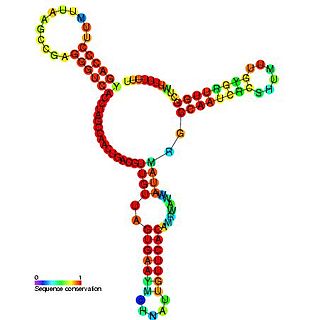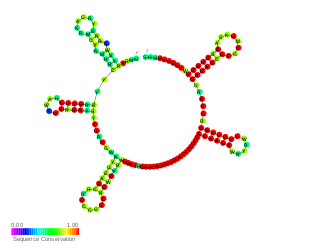Related Research Articles

Bonnie Lynn Bassler is an American molecular biologist who has researched chemical communication between bacteria known as quorum sensing, and contributed to the idea that disruption of chemical signaling can be used as an antimicrobial therapy. She is the Squibb Professor in Molecular Biology and chair of the Department of Molecular Biology at Princeton University. She is a Howard Hughes Medical Institute Investigator and her research focuses on bacterial quorum sensing, which is the cell-to-cell communication in bacteria.
In biology, quorum sensing is the ability to detect and respond to cell population density by gene regulation. As one example, quorum sensing (QS) enables bacteria to restrict the expression of specific genes to the high cell densities at which the resulting phenotypes will be most beneficial. Many species of bacteria use quorum sensing to coordinate gene expression according to the density of their local population. In a similar fashion, some social insects use quorum sensing to determine where to nest. Quorum sensing may also be useful for cancer cell communications.
Secretion is the movement of material from one point to another, such as a secreted chemical substance from a cell or gland. In contrast, excretion, is the removal of certain substances or waste products from a cell or organism. The classical mechanism of cell secretion is via secretory portals at the cell plasma membrane called porosomes. Porosomes are permanent cup-shaped lipoprotein structure at the cell plasma membrane, where secretory vesicles transiently dock and fuse to release intra-vesicular contents from the cell.

Aliivibrio fischeri is a Gram-negative, rod-shaped bacterium found globally in marine environments. This species has bioluminescent properties, and is found predominantly in symbiosis with various marine animals, such as the Hawaiian bobtail squid. It is heterotrophic, oxidase-positive, and motile by means of a single polar flagella. Free-living A. fischeri cells survive on decaying organic matter. The bacterium is a key research organism for examination of microbial bioluminescence, quorum sensing, and bacterial-animal symbiosis. It is named after Bernhard Fischer, a German microbiologist.

Vibrio harveyi is a Gram-negative, bioluminescent, marine bacterium in the genus Vibrio. V. harveyi is rod-shaped, motile, facultatively anaerobic, halophilic, and competent for both fermentative and respiratory metabolism. It does not grow below 4 °C. V. harveyi can be found free-swimming in tropical marine waters, commensally in the gut microflora of marine animals, and as both a primary and opportunistic pathogen of marine animals, including Gorgonian corals, oysters, prawns, lobsters, the common snook, barramundi, turbot, milkfish, and seahorses. It is responsible for luminous vibriosis, a disease that affects commercially farmed penaeid prawns. Additionally, based on samples taken by ocean-going ships, V. harveyi is thought to be the cause of the milky seas effect, in which, during the night, a uniform blue glow is emitted from the seawater. Some glows can cover nearly 6,000 sq mi (16,000 km2).

Qrr is a non-coding RNA that is thought to be involved in the regulation of quorum sensing in Vibrio species. It is believed that these RNAs, guided by a protein, Hfq, can mediate the destabilisation of the quorum-sensing master regulators LuxR/HapR/VanT mRNAs.

In enzymology, a S-ribosylhomocysteine lyase is an enzyme that catalyzes the chemical reaction
Autoinducers are signaling molecules that are produced in response to changes in cell-population density. As the density of quorum sensing bacterial cells increases so does the concentration of the autoinducer. Detection of signal molecules by bacteria acts as stimulation which leads to altered gene expression once the minimal threshold is reached. Quorum sensing is a phenomenon that allows both Gram-negative and Gram-positive bacteria to sense one another and to regulate a wide variety of physiological activities. Such activities include symbiosis, virulence, motility, antibiotic production, and biofilm formation. Autoinducers come in a number of different forms depending on the species, but the effect that they have is similar in many cases. Autoinducers allow bacteria to communicate both within and between different species. This communication alters gene expression and allows bacteria to mount coordinated responses to their environments, in a manner that is comparable to behavior and signaling in higher organisms. Not surprisingly, it has been suggested that quorum sensing may have been an important evolutionary milestone that ultimately gave rise to multicellular life forms.

Lactonase is a metalloenzyme, produced by certain species of bacteria, which targets and inactivates acylated homoserine lactones (AHLs).

Autoinducer-2 (AI-2), a furanosyl borate diester or tetrahydroxy furan, is a member of a family of signaling molecules used in quorum sensing. AI-2 is one of only a few known biomolecules incorporating boron. First identified in the marine bacterium Vibrio harveyi, AI-2 is produced and recognized by many Gram-negative and Gram-positive bacteria. AI-2 arises by the reaction of 1-deoxy-3-dehydro-D-ribulose, which is produced enzymatically with boric acid, and is recognized by the two-component sensor kinase LuxPQ in Vibrionaceae.
Bacterial small RNAs (sRNA) are small RNAs produced by bacteria; they are 50- to 500-nucleotide non-coding RNA molecules, highly structured and containing several stem-loops. Numerous sRNAs have been identified using both computational analysis and laboratory-based techniques such as Northern blotting, microarrays and RNA-Seq in a number of bacterial species including Escherichia coli, the model pathogen Salmonella, the nitrogen-fixing alphaproteobacterium Sinorhizobium meliloti, marine cyanobacteria, Francisella tularensis, Streptococcus pyogenes, the pathogen Staphylococcus aureus, and the plant pathogen Xanthomonas oryzae pathovar oryzae. Bacterial sRNAs affect how genes are expressed within bacterial cells via interaction with mRNA or protein, and thus can affect a variety of bacterial functions like metabolism, virulence, environmental stress response, and structure.

In molecular biology, the LuxR-type DNA-binding HTH domain is a DNA-binding, helix-turn-helix (HTH) domain of about 65 amino acids. It is present in transcription regulators of the LuxR/FixJ family of response regulators. The domain is named after Vibrio fischeri luxR, a transcriptional activator for quorum-sensing control of luminescence. LuxR-type HTH domain proteins occur in a variety of organisms. The DNA-binding HTH domain is usually located in the C-terminal region of the protein; the N-terminal region often containing an autoinducer-binding domain or a response regulatory domain. Most luxR-type regulators act as transcription activators, but some can be repressors or have a dual role for different sites. LuxR-type HTH regulators control a wide variety of activities in various biological processes.
Vibrio campbellii is a Gram-negative, curved rod-shaped, marine bacterium closely related to its sister species, Vibrio harveyi. It is an emerging pathogen in aquatic organisms.

Bioluminescent bacteria are light-producing bacteria that are predominantly present in sea water, marine sediments, the surface of decomposing fish and in the gut of marine animals. While not as common, bacterial bioluminescence is also found in terrestrial and freshwater bacteria. These bacteria may be free living or in symbiosis with animals such as the Hawaiian Bobtail squid or terrestrial nematodes. The host organisms provide these bacteria a safe home and sufficient nutrition. In exchange, the hosts use the light produced by the bacteria for camouflage, prey and/or mate attraction. Bioluminescent bacteria have evolved symbiotic relationships with other organisms in which both participants benefit close to equally. Another possible reason bacteria use luminescence reaction is for quorum sensing, an ability to regulate gene expression in response to bacterial cell density.
The type VI secretion system (T6SS) is molecular machine used by a wide range of Gram-negative bacterial species to transport proteins from the interior of a bacterial cell across the cellular envelope into an adjacent target cell. While often reported that the T6SS was discovered in 2006 by researchers studying the causative agent of cholera, Vibrio cholerae, the first study demonstrating that T6SS genes encode a protein export apparatus was actually published in 2004, in a study of protein secretion by the fish pathogen Edwardsiella tarda.

4,5-Dihydroxy-2,3-pentanedione (DPD) is an organic compound that occurs naturally but exists as several related structures. The idealized formula for this species is CH3C(O)C(O)CH(OH)CH2OH, but it is known to exist as several other forms resulting from cyclization. It is not stable at room temperature as a pure material, which has further complicated its analysis. The (S)-stereoisomer occurs naturally. It is typically hydrated, i.e., one keto group has added water to give the geminal diol.
Blautia obeum is a species of anaerobic, gram-positive bacteria found in the gut.
Proteobiotics are natural metabolites which are produced by fermentation process of specific probiotic strains. These small oligopeptides were originally discovered in and isolated from culture media used to grow probiotic bacteria and may account for some of the health benefits of probiotics.

VqmR small RNA was discovered in Vibrio cholerae, a bacterium which can cause cholera, using differential RNA sequencing (sRNA-seq) under conditions of low and high cell density which were being used to study quorum sensing (QS). QS controls virulence and biofilm formation in Vibrio cholerae; it has been shown previously that it is directed by the Qrr sRNAs. VqmR has been shown to repress the expression of multiple mRNAs including the rtx toxin genes and the vpsT, which is required for biofilm formation. In fact, VqmR which is highly conserved in vibrionaceae, was shown to strongly inhibit biofilm formation by repressing the vpsT gene; it could be the link between biofilm formation and QS.

Bacterial secretion systems are protein complexes present on the cell membranes of bacteria for secretion of substances. Specifically, they are the cellular devices used by pathogenic bacteria to secrete their virulence factors to invade the host cells. They can be classified into different types based on their specific structure, composition and activity. Generally, proteins can be secreted through two different processes. One process is a one-step mechanism in which proteins from the cytoplasm of bacteria are transported and delivered directly through the cell membrane into the host cell. Another involves a two-step activity in which the proteins are first transported out of the inner cell membrane, then deposited in the periplasm, and finally through the outer cell membrane into the host cell.
References
- 1 2 3 4 5 Day; Maurelli (2001). "Shigella flexneri LuxS Quorum-Sensing System Modulates virB expression but is not Essential for Virulence". American Society for Microbiology. 69 (1): 15–23. doi:10.1128/IAI.69.1.15-23.2001. PMC 97850 . PMID 11119484.
- 1 2 3 4 5 6 Xaiver; Bassler (2003). "LuxS quorum sensing more than just a numbers game". Current Opinion in Microbiology. 6 (2): 191–197. doi:10.1016/S1369-5274(03)00028-6. PMID 12732311.
- ↑ Xu, Lin; Li (5 October 2006). "Role of the luxs Quorum sensing System in Bioflim Formation and Virulence of Staphylococcus epidermis". American Society for Microbiology. 74 (1): 488–96. doi:10.1128/IAI.74.1.488-496.2006. PMC 1346618 . PMID 16369005.
- 1 2 Schauder; Baslser (December 2001). "The luxs family of bacterial autoinducers: biosynthesis of a novel quorum-sensing signal molecule". Molecular Microbiology. 41 (2): 463–76. doi: 10.1046/j.1365-2958.2001.02532.x . PMID 11489131.
- 1 2 3 Miller; Xaiver, Bassler (2004). "Salmonella typhimurium Recognizes a Chemically Distinct Form of the Bacterial Quorum-Sensing Signal AI-2". Molecular Cell. 15 (5): 677–87. doi: 10.1016/j.molcel.2004.07.020 . PMID 15350213.
- ↑ Chen X, Schauder S, Potier N, Van Dorsselaer A, Pelczer I, Bassler BL, Hughson FM (Jan 2002). "Structural identification of a bacterial quorum-sensing signal containing boron". Nature. 415 (6871): 545–9. doi:10.1038/415545a. PMID 11823863.
- 1 2 Whitehead (2001). Quorum Sensing in Gram Negative bacteria. Department of Biochemistry University of Cambridge.
- ↑ Wongsuk, Thanwa; Pumeesat, Potjaman; Luplertlop, Natthanej (2016). "Fungal quorum sensing molecules: Role in fungal morphogenesis and pathogenicity". Journal of Basic Microbiology. 56 (5): 440–7. doi:10.1002/jobm.201500759. PMID 26972663.